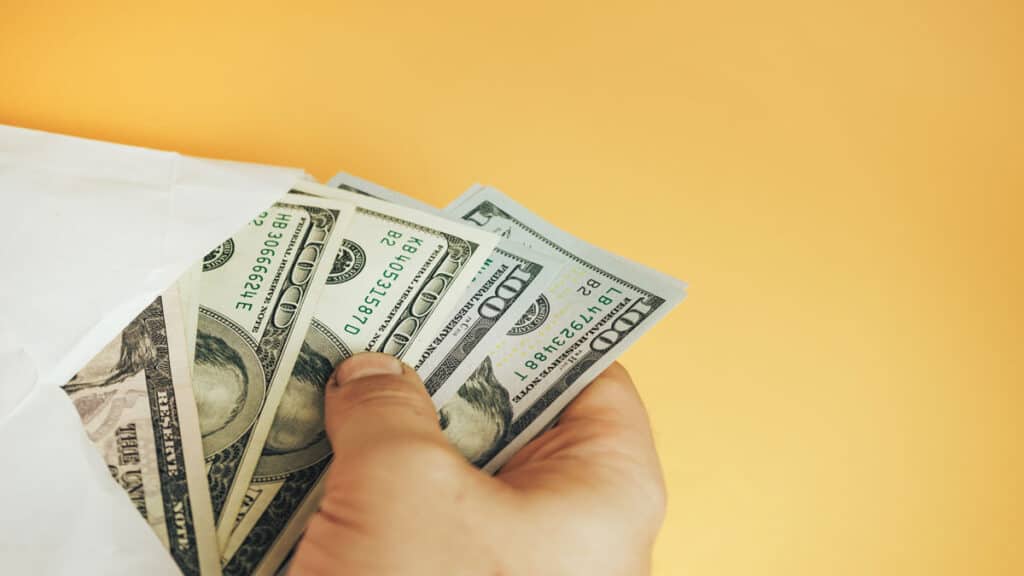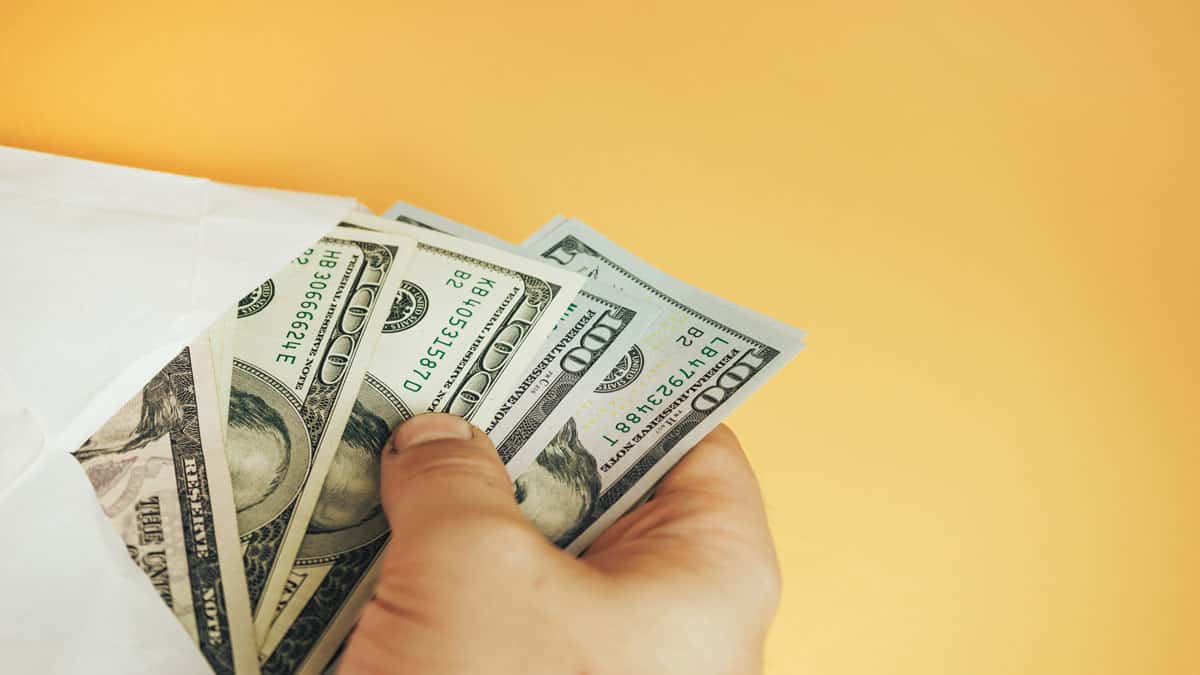THIS POST MAY CONTAIN AFFILIATE LINKS. PLEASE SEE MY DISCLOSURES. FOR MORE INFORMATION.
Budgeting is an essential skill that everyone should have.
It helps you manage your money better and avoid overspending.
The biggest problem with a traditional budget is that it is challenging to keep track of everything when you use digital payments like credit and debit cards.
The good news is cash stuffing solves this problem and others.
Cash stuffing is a popular budgeting technique that has become popular among Gen Z.
By paying for everything in cash, you spend less and can more easily keep tabs on your finances.
This opens the door to improving your financial life and getting ahead.
But how does cash stuffing work?
Here is everything you need to know about this budgeting method so you can use it to improve your finances.
KEY POINTS
Cash Stuffing 101
What Is Cash Stuffing?

Cash stuffing is a budgeting method for setting aside cash in various envelopes or designated accounts for specific expenses.
It has become very popular with Gen Z and is a TikTok money trend.
Using this method helps you stick to a budget.
The idea is that instead of using a credit or debit card for purchases, you physically use the cash you’ve set aside for that category.
That makes it easier to monitor and control spending.
This method is also sometimes referred to as the “envelope system.”
By allocating cash for each expense category, tracking where your money is going can be easier.
It also helps you adjust as needed to stay within your overall plan.
Cash stuffing helps you prioritize spending, avoid impulse purchases and stay within budget.
How Does A Cash Stuffing System Work?
Cash stuffing helps you plan how you spend and eliminate mindless shopping.
When paying with cash instead of credit cards, you cannot spend money on useless items whenever the impulse strikes.
For example, think how easy it is to see something you want and buy it. All you have to do is tap your watch using Apple Pay.
By avoiding mindless shopping, you can put more into your savings account or use it for financial goals instead of misusing it.
It is perfect for people with bad money habits.
For example, someone who cannot control impulse buying can benefit from this budgeting technique.
Cash stuffing makes you accountable for every dollar and helps you evaluate your spending.
It also helps you prioritize the most important bills, allowing you to live a more organized life.
This method helps you plan your income to ensure everything is allocated depending on your needs.
How To Get Started
Cash stuffing is one of the easiest budgeting methods that anyone can use.
All you need is cash, a list of expenses, and envelopes or binders to put the money in.
There are other small steps to take when starting a cash-stuffing system, and we have listed them below.
Read through to learn how to avoid credit card debt with cash stuffing.
#1. Determine Your Income
To start cash stuffing, you first need to know how much cash you have in total.
Start by calculating your monthly income, including regular paychecks, side hustles, or other sources of pay.
Doing this allows you to plan your expenditures and save money properly.
A clear image of how much money you have will let you calculate the percentages for each expense category.
#2. List Your Expenses
Make a list of all your monthly expenses, including fixed, like rent or mortgage payments, and variable, such as groceries, entertainment, or transportation.
Regarding debt, you need at least to list the minimum payment for each credit card.
Ideally, you will include a certain amount above this to pay off your debt faster.
Your list should also include your savings.
If you have a savings account you contribute to every month, list it here to avoid forgetting to allocate to it.
You can start with the most important expenses, which are the things you cannot live without.
Listing all your basic needs first lets you create a better structure for how you will be spending.
#3. Assign A Budget To Each Category
Once you make your expense list, you can start allocating money to the different categories of needs.
Decide how much you want to allocate to each category based on your income and expenses.
It’s important to be realistic and ensure your expenditures don’t exceed what you make.
Also, assuming that you listed the most important ones at the top, start with that and finish with the least important ones.
Anything that falls under needs should be a priority, and the wants should come after savings and needs.
For saving, however, you do not have to keep the money in cash.
You can deposit it to a bank account that is specifically for savings.
That is because keeping it with you as hard cash might tempt you to use it when one expense becomes too much, or you get an emergency.
#4. Withdraw Cash
You have now calculated your total income, compiled a list of your expenses, and allocated a percentage to each expenditure.
The next step is to get the money.
Go to your bank account and withdraw all the money you need to allocate to each envelope.
If you get paid in cash, the better.
Once you withdraw the budgeted amount for each category, place it in separate envelopes labeled with the category name.
You should have envelopes for rent, food, utility, and other bills.
#5. Start Using Cold Hard Cash
Start using cash for purchases within each category, and regularly monitor your envelopes to see how much you have left.
Make adjustments to your spending as needed.
You should be careful not to overspend because you cannot borrow from another envelope if you deplete the money in a particular spending category envelope.
Make sure that your money balances out in the allocation process to avoid putting too much or too little in any category.
When using this budgeting method, you cannot afford to do compulsive spending.
If you do that, you might exhaust your money before the next paycheck, which means you will suffer until you get more.
Cash stuffing is supposed to help you eliminate mindless online shopping and other spending habits to build savings.
You should therefore have a monthly savings goal you strive to achieve.
#6. Evaluate And Adjust
Regularly evaluate your budget and make adjustments if necessary.
This can help you stay on track and stick to it over time.
If you finish the month with certain envelopes empty and others with some money, you should go back to the drawing board and adjust the allocations.
However, the goal is to have some money left in every envelope at the end of the month.
Advantages Of Cash Stuffing

#1. Helps Control Spending
One of the main advantages of cash stuffing budgeting is that it makes it easier to control spending.
By using physical cash, it becomes more tangible, and you can see exactly how much you have left for each category, making it easier to avoid overspending.
Also, when the envelope is finally empty, you cannot spend any more because nothing is left.
Online purchases also contribute a great deal to overspending.
If you do not have any money in your digital wallets, you will not have the temptation to pay for things you do not need.
#2. Avoids Impulse Purchases
Impulse purchases can quickly add up and derail your budget.
With cash stuffing, the only limit is what you have set aside for each category, reducing the risk of impulsive purchases.
This method gives you the discipline to only spend on what is important, allowing you to do more with your money.
#3. Promotes Awareness
Cash stuffing budgeting helps you become more aware of how you are spending money.
By physically dividing your income into different categories, you can see exactly where it is going and make adjustments if needed.
You can also see the trends and either reduce some costs or add others.
Knowing how to manage your money is one of the best things to learn, as it helps you improve your finances to become financially independent.
#4. Easy To Start
Cash stuffing is a relatively straightforward method, making it easy to start.
All you need is a set of envelopes, cash, and a plan.
It does not require complicated learning because anyone can put money in an envelope and write down their expenditures in terms of priority.
#5. Flexibility
Cash stuffing is a flexible method adapted to your needs and spending habits.
You can add or remove categories, adjust budgets, and make other necessary changes to ensure it works for you.
#6. Better Organization
You can track your spending much better with your money in categories and allocated to specific uses.
This budgeting method offers better organization; you can quickly tell how much money you have spent.
That lets you know which categories take most of your money and either cut them off or reduce them.
#7. Avoid Credit Card Debt
When you pay with physical bills, you don’t have to worry about digging yourself into thousands of dollars of debt.
And, you avoid interest charges putting you further into debt.
Drawbacks Of Cash Stuffing

#1. Limited To Cash Purchases
One of the main limitations of cash stuffing budgeting is that you are limited to only using cash for purchases.
This can be a drawback for those who prefer to use credit cards for rewards or cashback or who prefer the convenience of online or mobile payments.
You cannot use bank cards or online payments linked to your bank account.
#2. Risk Of Loss Or Theft
Carrying cash in large amounts can be risky, as there is a risk of loss or theft.
This is particularly true for people who travel frequently or live in areas with high crime rates.
If you lose the money to thieves or misplace it, you will be in a deficit and might use your savings to compensate for the lost money.
#3. Inflexible
If your budgeted amount for a category runs out, you cannot make any more purchases in that category until you allocate more money.
Also, if one category is affected by rising prices, you might be unable to change your allocations to fit the price rise.
This can be a drawback for people who need to be able to adjust their spending on the fly.
#4. Time Consuming
Cash stuffing requires time and effort to keep track of your spending, allocate cash, and make adjustments as needed.
This can be a drawback for busy people or who prefer a more hands-off approach to budgeting.
#5. Not Ideal For All Situations
Cash stuffing may not be ideal for all situations, such as large or unexpected expenses, or for people with trouble sticking to a plan.
It can therefore be inconvenient to some people because it limits their purchases.
Some people with variable incomes also have trouble with this type of budget.
However, others who don’t have a steady paycheck swear by this budget type.
#6. Don’t Earn Interest
Another disadvantage when you cash stuff is that you miss out on earning interest.
If you put your money in accounts with earning potential, you can increase your amount by a certain percentage.
So for someone who wants to see their wealth grow, this might not be the best method to manage their finances.
Final Thoughts
Cash stuffing can be a valuable and effective method for managing personal finances, particularly for those who struggle with buying on impulse or overspending.
However, it’s essential to consider the limitations of this method and whether it is the best option for your individual needs and situation.
As with any budgeting method, it’s crucial to find one that works for you and evaluate and adjust your budget regularly.
I have over 15 years experience in the financial services industry and 20 years investing in the stock market. I have both my undergrad and graduate degrees in Finance, and am FINRA Series 65 licensed and have a Certificate in Financial Planning.
Visit my About Me page to learn more about me and why I am your trusted personal finance expert.

